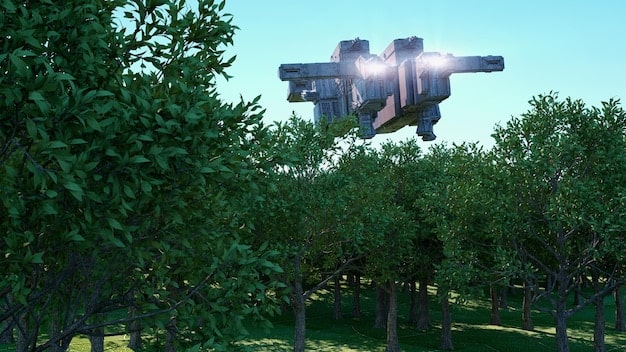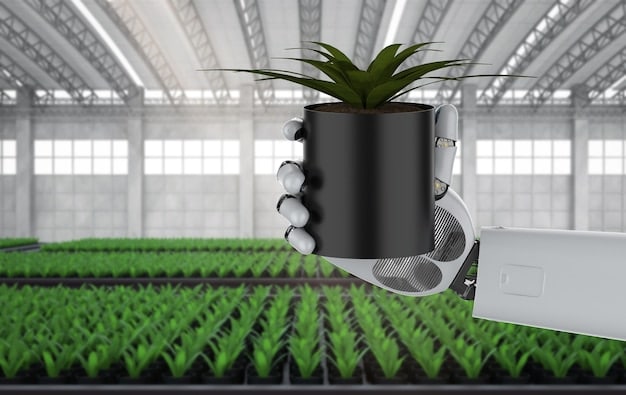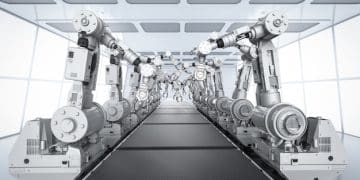Robotics in US Agriculture: Boost Crop Yields by 20% with New Tech

The integration of robotics in US agriculture is poised to revolutionize farming practices, potentially leading to a significant increase in crop yields by as much as 20% through enhanced efficiency, precision, and sustainability.
The agricultural landscape in the United States is on the cusp of a profound transformation. As global demand for food escalates and environmental concerns intensify, the traditional farming methods face increasing pressure to adapt and innovate. This is where the burgeoning field of robotics in US agriculture: how new tech could increase crop yields by 20% steps in, promising not just incremental improvements, but a revolutionary leap in productivity and sustainability. Dive in to explore how intelligent machines are reshaping the future of American farms.
The Dawn of Agricultural Automation
For centuries, agriculture has been a labor-intensive endeavor, highly dependent on manual effort and traditional machinery. However, the 21st century is ushering in an era where technology is becoming as fundamental to farming as soil and water. The concept of agricultural automation, particularly through robotics, is moving from theoretical discussions to practical applications on farms across the United States. This shift is driven by a confluence of factors, including labor shortages, the need for increased efficiency, and the imperative for sustainable practices.
Robotics offers the promise of performing repetitive, strenuous, or precise tasks with unparalleled accuracy and consistency. Farmers are increasingly adopting these technologies to manage everything from planting and harvesting to monitoring crop health and managing livestock. The evolution of robotics in agriculture is not merely about replacing human labor; it’s about augmenting human capability, allowing farmers to focus on strategic decision-making while machines handle the intricate details of daily operations.
Addressing Labor Shortages and Costs
One of the most pressing challenges facing US agriculture today is a persistent labor shortage. Manual labor is often seasonal, physically demanding, and increasingly difficult to source. Robotics provides a compelling solution, automating many of these tasks and reducing reliance on a fluctuating workforce. This not only mitigates the labor crunch but also stabilizes operational costs, making farming a more predictable and financially viable enterprise.
- Reduced Manual Labor: Robots can handle tedious, repetitive tasks like weeding, picking, and grading produce.
- Increased Efficiency: Machines operate tirelessly, often 24/7, without fatigue, leading to higher output.
- Cost Stabilization: Automation can lead to predictable labor expenses, insulating farms from wage fluctuations.
- Improved Safety: Robots can perform hazardous tasks, reducing risks to human workers.
Furthermore, the integration of automation can free up human workers for more skilled roles, such as operating and maintaining robotic systems, analyzing data, and strategic planning. This shift can elevate the overall skill set within the agricultural workforce, fostering a more technologically adept generation of farmers and agricultural professionals. It represents a significant step towards a sustainable and resilient agricultural future.
Enhancing Precision and Sustainability
Precision agriculture, enabled by robotics, is revolutionizing how resources are managed on the farm. Instead of blanket applications, robots can perform highly localized interventions, applying water, fertilizers, and pesticides only where and when needed. This targeted approach minimizes waste, reduces environmental impact, and significantly enhances the efficiency of resource utilization.
For example, robotic systems equipped with advanced sensors can detect individual weeds or diseased plants and treat them precisely, rather than spraying an entire field. This not only cuts down on chemical usage but also safeguards soil health and biodiversity. The environmental benefits extend to water conservation, as robotic irrigation systems can deliver precise amounts of water directly to the plant roots, preventing runoff and evaporation losses. This level of precision was previously unimaginable with traditional farming methods.
The dawn of agricultural automation thus signifies a monumental shift. It’s about empowering farmers with tools that enhance productivity, ensure economic viability, and champion environmental stewardship, paving the way for a more robust and sustainable food system in the United States.
Precision Planting and Harvesting Automation
The ability to plant and harvest crops with unparalleled precision is a cornerstone of modern agricultural robotics. These tasks, traditionally labor-intensive and prone to human error, are now being revolutionized by highly sophisticated machines. Precision planting ensures optimal spacing and depth for each seed, crucial for uniform crop growth and maximum yield potential. Similarly, robotic harvesting systems are designed to pick produce gently and efficiently, minimizing damage and waste.
Traditional planting methods often lead to uneven seed distribution, resulting in some areas with overcrowding and others with sparse growth. Robotic planters, equipped with GPS and real-time kinematic (RTK) navigation, can place seeds with centimeter-level accuracy. This precision optimizes the use of land, nutrients, and water, giving each plant the best possible start. The uniformity achieved through precision planting leads to more consistent crop development, which simplifies subsequent management tasks and improves overall yield predictability.

Automated Harvesting: Reducing Waste and Labor
Harvesting is often the most critical and labor-intensive phase of crop production. For delicate crops like strawberries, tomatoes, or apples, manual harvesting is still prevalent, but it’s increasingly unsustainable due to labor shortages and rising costs. Robotic harvesters are emerging as a viable solution, capable of identifying ripe produce using computer vision and picking it without causing damage.
- Gentle Handling: Robotic grippers are designed to mimic human hands, minimizing bruising and damage to delicate fruits and vegetables.
- Selective Harvesting: Vision systems allow robots to identify and pick only ripe produce, leaving unripe ones to mature, increasing overall yield quality.
- Extended Hours: Robots can operate continuously, including at night, reducing the time sensitive window for harvesting perishable crops.
The financial implications for farmers are substantial. Reduced labor dependence lowers operational costs, while minimized crop damage and selective harvesting increase the marketable yield. For example, a robotic strawberry picker can operate around the clock, harvesting only ripe berries, whereas human pickers might occasionally pick unripe ones or miss ripe ones due to fatigue. This efficiency translates directly into economic benefits and a reduction in food waste at the farm level.
Yield Mapping and Optimization
Beyond the physical acts of planting and harvesting, robotic systems contribute significantly to data collection and analysis. As these machines traverse the fields, they can simultaneously gather data on soil conditions, plant health, and yield variations across different zones. This “yield mapping” provides farmers with granular insights into their fields, allowing for optimized resource allocation in future seasons.
For instance, if yield maps indicate that a particular section of a field consistently underperforms, farmers can investigate the underlying causes—be it nutrient deficiencies, water stress, or pest issues—and implement targeted solutions. This data-driven approach moves agriculture from a generalized practice to a highly customized and optimized science. The continuous feedback loop from robotic operations to data analysis enables a perpetual cycle of improvement, making farming more efficient and profitable.
The shift towards precision planting and automated harvesting underscores a fundamental change in agricultural operations. These technologies are not just tools; they are integral components of a smart farming ecosystem that promises to boost productivity, minimize waste, and secure the future of food production.
Drones and Sensor Technology for Crop Monitoring
The sky above American farms is becoming increasingly populated with an array of advanced technologies, most notably drones equipped with sophisticated sensors. These aerial platforms provide an unprecedented vantage point for monitoring crop health, irrigation patterns, and pest infestations across vast stretches of land. Paired with ground-based sensors, this integrated system offers farmers real-time, actionable insights that were previously unattainable or required extensive manual inspection.
Drones, or unmanned aerial vehicles (UAVs), are proving invaluable for their ability to cover large areas quickly and efficiently. Equipped with multi-spectral, hyperspectral, or thermal cameras, they can capture data that is invisible to the naked eye. For example, multi-spectral cameras can assess plant vitality by measuring the light reflected by leaves, indicating stress from drought, disease, or nutrient deficiency long before visible symptoms appear. This early detection capability allows farmers to intervene proactively, preventing widespread crop damage and yield loss.
Early Detection of Stress and Disease
One of the most significant advantages of drone and sensor technology is the capacity for early identification of plant stress and disease. Traditional methods often rely on visual inspection, by which time the problem may have already spread. Drones, however, can identify subtle changes in plant health signatures, enabling targeted treatment before the issue escalates. This leads to reduced chemical usage and healthier crops.
- Nutrient Deficiency Mapping: Drones can identify areas with nutrient imbalances, allowing for precise fertilization.
- Pest and Disease Hotspots: Thermal and multispectral imaging can pinpoint affected areas, enabling targeted pesticide application.
- Water Stress Identification: Sensors detect plant water levels, guiding efficient irrigation strategies.
This early detection capability extends beyond just diagnosing issues; it also facilitates preventive measures. For instance, by mapping historical data on disease outbreaks, farmers can use drones to monitor susceptible areas more closely in anticipation of new outbreaks. The proactive approach results in fewer yield losses and a more robust crop management strategy, significantly contributing to the overall productivity and resilience of the farm.
Optimizing Irrigation and Resource Management
Water is a precious resource, and its efficient use is paramount in modern agriculture. Drones and ground sensors provide critical data for optimizing irrigation schedules and water application. Thermal cameras on drones can detect variations in canopy temperature, which directly correlate with plant water stress. This allows farmers to identify precisely which areas of a field need irrigation and how much water to apply, preventing both over-watering and under-watering.
Coupled with soil moisture sensors, which provide real-time data from the ground, farmers can develop highly precise irrigation plans that conserve water without compromising crop health. This level of granular control is not only environmentally responsible but also economically beneficial, reducing water consumption and energy costs associated with pumping. The integration of these technologies creates a holistic view of the farm’s water needs, enabling adaptive and responsive irrigation management that aligns with sustainable farming principles.
In essence, drones and sensor technology are transforming crop monitoring from a reactive process into a predictive science. By providing comprehensive, real-time data, these tools empower farmers to make informed decisions that optimize resource use, mitigate risks, and ultimately enhance the productivity and sustainability of agricultural operations across the US.
Autonomous Tractors and Field Operations
The vision of completely autonomous tractors operating across vast agricultural fields, tirelessly and precisely, is rapidly becoming a reality in the United States. These machines represent a significant leap forward in agricultural automation, promising to redefine on-field operations from tilling and planting to spraying and harvesting. Autonomous tractors are equipped with advanced GPS, Lidar, radar, and vision systems, allowing them to navigate complex terrains, identify obstacles, and execute tasks with remarkable accuracy, independent of human intervention.
The development of these self-driving machines addresses several critical challenges for modern farming. They mitigate the impact of labor shortages, which often limit the scale and timeliness of field operations. Furthermore, their ability to operate with extreme precision minimizes fuel consumption and optimizes the application of inputs like fertilizers and seeds, leading to both economic and environmental benefits. The continuous, consistent operation of autonomous tractors can also lead to more uniform field conditions, which in turn can foster healthier and more productive crops.
Enhancing Efficiency and Reducing Operational Costs
The primary advantage of autonomous tractors lies in their capacity to significantly enhance operational efficiency. Unlike human operators, these machines do not require breaks, sleep, or succumb to fatigue. They can work around the clock, accelerating key agricultural timelines such as planting and harvesting, particularly crucial during narrow weather windows.
- 24/7 Operations: Autonomous tractors can work continuously, maximizing productive hours.
- Fuel Efficiency: Optimized routes and consistent speeds reduce fuel consumption.
- Labor Cost Reduction: Decreased reliance on human operators for repetitive field tasks.
- Precision Agriculture Integration: Seamlessly integrates with other precision farming technologies for data sharing.
This round-the-clock capability means farmers can complete critical tasks more quickly and reliably, reducing the risk of weather-related crop damage or missed growth opportunities. The financial savings extend beyond just labor; the optimized use of fuel, reduced wear and tear on machinery due to consistent operation, and the precision application of expensive inputs all contribute to lower overall operational costs. This economic advantage makes autonomous tractors an increasingly attractive investment for large-scale agricultural enterprises.
Safety and Data Collection Capabilities
Beyond efficiency, autonomous tractors offer significant improvements in safety and data collection. By removing human operators from potentially hazardous environments, such as fields being sprayed with pesticides or operating heavy machinery on uneven terrain, the risk of accidents is greatly reduced. Equipped with sophisticated sensor arrays, these tractors can detect and avoid obstacles, ensuring safe operation even in complex agricultural settings.

Moreover, autonomous operations generate vast amounts of valuable data. As they traverse fields, these tractors can collect information on soil conditions, crop emergence, and the efficacy of applied treatments. This real-time data feeds into farm management systems, providing farmers with detailed insights into their fields’ performance. This data-driven approach enables continuous optimization of farming practices, leading to better resource allocation and higher yields over time. It transforms farming into a high-tech data science, allowing for incredibly precise and informed decision-making.
Autonomous tractors are not merely an evolution of farm machinery; they are a revolution in how large-scale farming operations are conducted. They promise a future where agriculture is more efficient, safer, and inherently data-driven, helping to meet the ever-growing demand for food while minimizing environmental impact.
Challenges and Adoption Hurdles
While the promise of robotics in US agriculture is immense, the path to widespread adoption is not without its challenges. Integrating advanced technologies into traditional farming practices involves more than just technological readiness; it encompasses economic, social, and logistical hurdles that must be carefully navigated. Understanding these obstacles is crucial for developing effective strategies to accelerate the beneficial impact of agricultural robotics.
One significant barrier is the initial capital investment required for these sophisticated machines. Robotic systems, autonomous tractors, and advanced sensor arrays represent substantial upfront costs for farmers, many of whom operate on thin margins. The return on investment, while potentially high in the long term, may not be immediately apparent, making it a difficult decision for smaller farms or those already facing financial constraints. Furthermore, the rapid pace of technological development means that systems can quickly become obsolete, adding to the financial risk.
Cost and Accessibility for Smaller Farms
The high cost of entry for robotic solutions often puts them out of reach for small to medium-sized farms, which constitute a significant portion of the agricultural landscape in the US. This creates a potential divide, where larger, more affluent operations can leverage technology to gain a competitive edge, while smaller farms struggle to adapt and remain viable. Bridging this gap requires innovative financing models, government subsidies, and the development of more affordable, modular robotic solutions.
- High Upfront Investment: Robotic equipment can be prohibitively expensive for many farms.
- Financing Options: Limited access to specialized loans or grants for agricultural technology.
- Scale Disadvantage: Smaller farms may not have the land area to justify large-scale robotic investments.
- Maintenance and Support: Lack of local expertise for repairs and technical assistance.
Efforts to make these technologies more accessible include the emergence of “robot-as-a-service” models, where farmers can rent robotic equipment for specific tasks or seasons, reducing the need for outright purchase. Additionally, research and development are focusing on creating more versatile and cost-effective robots that can perform multiple functions, thereby maximizing their utility and financial viability for a wider range of farm sizes.
Technological Integration and Skill Gaps
Even when cost is not an issue, integrating complex robotic systems into existing farm infrastructure presents its own set of challenges. Farmers need to be able to seamlessly connect new technologies with their current machinery and management systems. This requires a level of technological literacy that not all agricultural workers currently possess, leading to a significant skill gap.
There is a growing need for training programs that equip farmers and farmhands with the knowledge and skills necessary to operate, maintain, and troubleshoot robotic systems. Universities, agricultural extension services, and even manufacturers are stepping up to provide this crucial education. Furthermore, the interoperability of different robotic systems from various manufacturers remains a challenge. Establishing industry standards for data exchange and system compatibility will be vital for a truly integrated and efficient robotic farm ecosystem.
Addressing these challenges requires a concerted effort from policymakers, technology developers, and the agricultural community itself. By focusing on affordability, accessibility, and education, the path to widespread adoption of robotics in US agriculture can be smoothed, ensuring that its transformative benefits are available to all.
Future Outlook and Economic Impact
The future of US agriculture is inextricably linked to the continued advancement and integration of robotics. As these technologies mature and become more accessible, their economic impact is projected to be profound, fundamentally reshaping the agricultural value chain. The initial investments in research and development, coupled with early adoption, are laying the groundwork for a more efficient, productive, and sustainable food system capable of meeting future global demands.
Projections suggest that robotics will play a critical role in realizing significant increases in crop yields, with some estimates pointing towards a 20% boost. This uplift is not merely due to sheer automation but rather the synergistic effect of enhanced precision, optimized resource utilization, and the ability to operate across extended hours without human fatigue. The economic ramifications extend beyond the farm gate, influencing supply chains, food prices, and even national food security.
Market Growth and Investment Trends
The agricultural robotics market is experiencing robust growth, attracting significant investment from venture capitalists, technology firms, and traditional agricultural machinery manufacturers. This surge in interest is a clear indicator of the perceived potential and profitability of these innovative solutions. As competition intensifies, it is expected that the cost of these technologies will gradually decrease, making them more attainable for a broader spectrum of agricultural operations.
- Increased R&D Investment: Growing private and public sector investment in agricultural robotics.
- Startup Ecosystem: Emergence of numerous ag-tech startups focusing on robotic solutions.
- Consolidation and Partnerships: Larger companies acquiring or partnering with innovative smaller firms.
- Global Market Expansion: US-developed robotics technologies finding markets worldwide, reinforcing export potential.
The development of new business models, such as robot-as-a-service and joint ownership programs, will further democratize access to these high-tech tools. This market dynamism will foster innovation, drive down costs, and lead to the development of even more specialized and effective robotic solutions tailored to specific agricultural needs, from row crops to specialty fruits and vegetables.
Societal and Environmental Benefits
Beyond the immediate economic advantages for farmers, the widespread adoption of agricultural robotics promises substantial societal and environmental benefits. Increased yields contribute to global food security, ensuring a more stable and abundant food supply for a growing population. Reduced production costs, stemming from efficiency gains, can translate into more affordable food for consumers, improving access and reducing food insecurity.
Environmentally, the precision capabilities of robotics will lead to a significant reduction in the use of water, fertilizers, and pesticides. This minimizes agricultural runoff, preserves soil health, and protects biodiversity, leading to a more sustainable and ecologically friendly farming system. The reduction in fuel consumption by autonomous machinery also contributes to lower carbon emissions, aligning with broader climate change mitigation efforts. The shift towards robotic agriculture is thus a multifaceted transformation, promising a future where food production is not only more efficient but also profoundly more sustainable and equitable.
The journey towards a fully roboticized agricultural sector in the US is long, but the trajectory is clear. As technology continues to evolve and overcome current challenges, the economic impact will be transformative, ushering in an era of unprecedented productivity, sustainability, and resilience in food production.
| Key Aspect | Brief Description |
|---|---|
| 🤖 Automation Growth | Robotics rapidly expanding in US farms to address labor, efficiency, and sustainability needs. |
| 🌾 Yield Increase | New tech could boost crop yields by 20% through precision and continuous operation. |
| 💧 Resource Optimization | Drones & sensors enable precise water, fertilizer, and pesticide application, reducing waste. |
| 💰 Economic Impact | Reduced costs, increased profits, and new service models are reshaping agri-business. |
Frequently Asked Questions About Agricultural Robotics
▼
Robotics achieves increased yields through several mechanisms. Precision planting ensures optimal spacing and depth for each seed, leading to uniform growth. Automated pest and disease detection allows for early, targeted intervention, preventing widespread crop loss. Additionally, optimized irrigation and nutrient application reduce waste and support stronger plant development, cumulatively boosting overall productivity and yield by a significant margin.
▼
A diverse range of robots is emerging in US agriculture. These include autonomous tractors for field operations like tilling and spraying, robotic harvesters for delicate crops such as strawberries, and drone-based systems equipped with sensors for aerial monitoring of crop health and irrigation needs. Ground-based robots also perform tasks like weeding and soil analysis, each playing a crucial role in modernizing farm practices.
▼
Currently, the high initial cost of agricultural robotics can be a significant hurdle for smaller farms. However, the industry is seeing the rise of innovative solutions like “robot-as-a-service” models, where farmers can lease or rent robots. This approach lowers the barrier to entry, making advanced technology more accessible. Government subsidies and grant programs are also being developed to support small- and medium-sized farms in adopting these transformative technologies.
▼
Robotics offers substantial environmental benefits. By enabling precision agriculture, robots reduce the overuse of water, fertilizers, and pesticides, minimizing runoff and preserving soil health. Targeted application means fewer chemicals in the environment. Additionally, optimized field operations by autonomous machines lead to reduced fuel consumption and greenhouse gas emissions, contributing to more sustainable and eco-friendly farming practices that benefit biodiversity.
▼
Modern agricultural robots are equipped with sophisticated navigation and perception systems, including GPS, Lidar, radar, and advanced computer vision. These technologies allow them to accurately map and navigate diverse terrains, detect and avoid obstacles like trees or uneven ground, and operate safely in dynamic farm environments. Continuous data processing and machine learning capabilities enable them to adapt to changing conditions and improve their performance over time.
Conclusion
The integration of advanced robotics into US agriculture is more than just a technological upgrade; it represents a fundamental shift towards a more efficient, productive, and sustainable food system. From precision planting and automated harvesting to drone-based crop monitoring and autonomous field operations, these innovations are poised to enhance crop yields significantly, potentially by the ambitious target of 20%. While challenges such as high initial costs and skill gaps persist, the economic and environmental benefits are too substantial to ignore. As research continues to advance and adoption becomes more widespread, robotics will undoubtedly redefine the landscape of American farming, ensuring food security and environmental stewardship for future generations.





